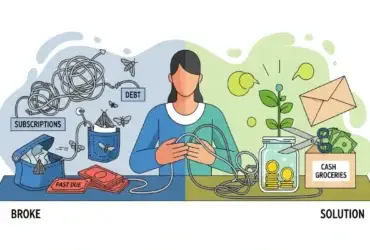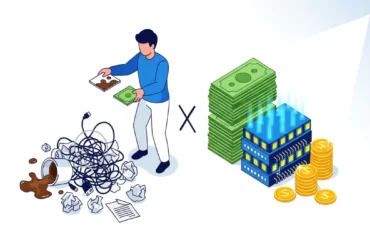Ever paid your car or health insurance bill and thought, “Where does all this money actually go? Are they just swimming in cash?” It’s a great question, and the answer is simpler than you might think. Many people believe it’s a complicated secret, but it’s not.
Today, I’m going to show you exactly how do insurance companies make money. We’ll break it down into easy-to-understand steps, with no confusing jargon. By the end of this guide, you’ll see the entire picture clearly.
“The world of finance is designed to sound complicated, but it doesn’t have to be. My goal is to empower you with simple knowledge. When you understand how insurance works, you become a smarter, more confident consumer.”
Why Understanding This Is Important for You
Before we dive in, let me share a quick story. For years, I worked helping families with their budgets. A common point of confusion was always insurance. They saw it as just another bill—a necessary evil. They didn’t understand why their rates would go up or what happened to the money they paid if they never filed a claim.
Once I started explaining the simple business model behind it, a lightbulb went on. They realized their insurance premium wasn’t just vanishing. It was part of a giant financial system designed to protect people. Understanding how insurance companies make money helps you appreciate what you’re paying for and makes you a savvier shopper.
How Insurance Companies Make Money: A Simple 3-Step Guide

At its heart, an insurance company does three main things to generate profit. Think of it like a three-legged stool—it needs all three legs to be stable and successful.
Step 1: Collecting Money (Premiums) – The Shared Pot

This is the most obvious part. You and millions of other people pay a regular fee to the insurance company. This fee is called a premium.
Imagine a small village where everyone puts $10 into a community pot each month. This pot is for helping anyone whose house accidentally catches fire.
- You pay a premium for your car, home, health, or life insurance policy.
- The insurance company collects all these premiums from thousands or millions of customers (policyholders).
- This creates a massive pool of cash.
This pool of money is the starting point. But just collecting money isn’t enough to make a profit, especially when they have to pay out for accidents and disasters!
Step 2: Smart Guessing (Underwriting) – Managing Risk

This is where the real “brains” of the operation come in. The insurance company can’t just collect $10 from everyone. They need to figure out how likely it is that something bad will happen. This process is called underwriting.
Underwriters are like professional guessers. Their job is to calculate the risk of insuring you.
- They look at your age, your health, your driving record, where you live, and other factors.
- Someone who is a higher risk (e.g., a new driver with a sports car) will pay a higher premium than a lower-risk person (e.g., an experienced driver with a perfect record).
- The goal of underwriting is to collect enough money in premiums to cover the expected costs of claims.
When they do this well, they take in more money from premiums than they pay out in claims. This difference is called an underwriting profit. It’s the first way an insurance company makes money.
Step 3: Making Money with Money (Investments) – The Secret Sauce

This is the most powerful part of the business and the one most people don’t know about. What happens to that giant pool of premium money while it’s waiting to be paid out for claims?
It doesn’t just sit in a bank account. Insurance companies invest it!
This giant pile of cash from premiums is called the “float.” They take this float and invest it in very safe, stable things like government bonds, high-quality stocks, and real estate.
- You pay your premium on January 1st.
- You might not file a claim all year.
- For that entire year, the insurance company is earning interest and returns on your money.
Now multiply that by millions of customers. This investment income is a huge source of profit. In fact, many insurance companies can afford to have a small underwriting loss (paying out slightly more in claims than they collect in premiums) because they make so much money from investing the float.
7 Insider Tips to Truly Understand the Insurance Business
To move from just knowing the basics to truly understanding the industry, here are some deeper insights. Thinking like an insider helps you become a smarter customer.
1. Decode the “Combined Ratio”: The Insurer’s Health Score
- What It Is: This is the single most important number for gauging an insurer’s core business health. It’s calculated as (Paid Claims + All Expenses) / Collected Premiums. A ratio under 100% means they made a profit on their underwriting (their “day job”). A ratio over 100% means they lost money on underwriting and are relying on their investments to be profitable.
- Why It Matters to You: An insurer with a consistently low combined ratio is highly efficient and disciplined. It means they are excellent at pricing risk and managing costs. While a ratio over 100% isn’t always a red flag (especially after a year of major disasters), a consistently high ratio could suggest the company is struggling operationally, which could potentially impact service down the line.
2. Appreciate the Actuaries: The Financial Fortune-Tellers
- What They Are: Actuaries are highly trained professionals who are the architects of insurance pricing. They use a powerful blend of statistics, data science, and financial theory to predict the future cost of risk. They aren’t guessing; they are calculating probabilities on a massive scale.
- Why They Matter to You: Every dollar of your premium is a direct result of an actuary’s calculations. When they determine that the risk of accidents for your specific car model or in your specific zip code has increased, they adjust the models, and your rate changes accordingly. They are the reason insurance is a science, not a gamble.
3. Understand “Hard” vs. “Soft” Markets: The Industry’s Cycle
- What It Is: The insurance industry moves in cycles. A “hard market” is characterized by rising premiums, stricter underwriting, and less competition. This usually happens after a period of large industry-wide losses. A “soft market” is the opposite: lower premiums, more flexible terms, and intense competition among insurers to win your business.
- Why It Matters to You: Knowing what kind of market you’re in gives you power. In a soft market, you should shop your policy aggressively, as insurers are eager for customers and offering great rates. In a hard market, your primary goal might be simply to maintain good, stable coverage, as deals are scarce.
4. Learn About Reinsurance: The Insurer’s Insurance Policy
- What It Is: No single insurance company can afford to cover a multi-billion dollar catastrophe like a major hurricane or earthquake. They transfer a portion of their risk to other, even larger companies called reinsurers. In essence, they buy their own insurance policy to protect themselves from huge losses.
- Why It Matters to You: Reinsurance is the ultimate safety net that ensures the company you pay your premium to can actually pay your claim after a massive disaster. It brings stability to the entire global financial system and prevents regional insurers from going bankrupt when they are needed most.
5. Differentiate Loss Ratio from Combined Ratio
- What It Is: While the Combined Ratio shows overall operational health, the Loss Ratio is more specific. It measures Paid Claims / Collected Premiums. It tells you exactly what percentage of every premium dollar was used to pay for other people’s claims.
- Why It Matters to You: This number is a primary driver of rate increases. If an insurer’s loss ratio for drivers in your city jumps from 65% to 80% due to more accidents and higher repair costs, they will raise rates for everyone in that group to bring the ratio back down to a sustainable level.
6. Recognize the Two Faces of Profit
- What It Is: It’s crucial to distinguish between the two profit centers. Underwriting Profit is earned from disciplined risk-taking. Investment Profit is earned from skillfully managing the float.
- Why It Matters to You: Many of the world’s most successful insurance companies, especially those run by legendary investors like Warren Buffett, often break even or take a small loss on underwriting. Their genius lies in generating massive, long-term returns on the enormous float they command. This model allows them to offer competitive premiums while their investment engine drives the business forward.
7. See Your Data as Their Gold: The Rise of Telematics
- What It Is: Traditionally, insurers priced your risk based on proxies—your age, your car, your zip code. Now, with telematics (like a plug-in device or smartphone app), they can use your actual driving data: how fast you drive, how hard you brake, and what time of day you’re on the road.
- Why It Matters to You: This is the future of insurance pricing. It represents a trade-off: in exchange for your privacy, you can get a premium based on your actual behavior, not the behavior of your demographic group. For safe drivers, this can lead to significant savings.
Common Misconceptions: 3 Myths About Insurance Profits
Myth 1: They want to deny every claim.
- Reality: While they fight fraud, their business relies on paying legitimate claims. A reputation for not paying would destroy their business. They budget to pay claims; it’s part of the model.
Myth 2: My unused premium is my money.
- Reality: The premium you pay becomes part of the shared pool. It’s no longer your individual money but part of the fund used to pay for everyone’s claims.
Myth 3: Insurance is a scam.
- Reality: Insurance is a business based on the mathematical principle of shared risk. It allows society to function by providing a safety net so that one accident doesn’t bankrupt a person or company.
A Quick Look: How Different Insurance Types Make Money
While the basic model is the same, the risks are different.
- Health Insurance: Makes money when the premiums collected from a large group of healthy people are greater than the medical claims from the sick people in that group. They also earn big on investment float.
- Life Insurance: The “risk” here is timing. They invest your premiums for decades, so investment income is the primary way they profit. They have calculated, based on life expectancy, how long they will likely have your money to invest.
- Car & Home Insurance (Property & Casualty): This is more focused on underwriting profit. The risk of a car crash or house fire is higher and less predictable than with life insurance, so they need to be very good at pricing premiums to cover claims.
Troubleshooting: What Happens When Insurers Face Huge Losses?
What if a giant hurricane hits Florida and an insurance company has to pay out billions in claims, far more than it collected in premiums?
This is a great question that shows the importance of regulation.
- They Use Their Reserves: Insurers are required by law to keep a large amount of money in cash reserves specifically for this kind of event.
- Reinsurance Kicks In: This is where their own insurance policy (reinsurance) helps cover the massive losses.
- Government Oversight: Organizations like the National Association of Insurance Commissioners (NAIC) set rules to ensure companies are financially healthy enough to withstand disasters. This protects you, the consumer. You can learn more about how the industry is regulated from authoritative sources like Investopedia’s guide on insurance operations.
Conclusion
So, how do insurance companies make money? It’s not magic, and it’s not a mystery. They do it in three straightforward ways:
- Underwriting Profit: Collecting more in premiums than they pay in claims.
- Investment Income: Earning returns by investing the “float” (your premiums).
- A Combination of Both: A healthy company does both well!
By understanding this simple model, you’re no longer just a customer paying a bill. You’re an informed consumer who understands the value and the business of the protection you’re buying.
If you enjoyed this guide, explore more simple answers to complex questions over at howtoresults.com.
FAQs
What are the two main ways insurance companies make money?
The two main profit engines are underwriting income and investment income. Think of underwriting income as the profit from their “day job”—it’s the money left over after paying all claims and business expenses from the premiums they collect. Investment income is their powerful “second business”—it’s the money they earn by investing the massive pool of premiums (the float) in stocks, bonds, and other assets before it’s needed to pay claims. A healthy insurer excels at both.
Do insurance companies want you to make a claim?
This is a nuanced question. In a purely financial sense, every claim is a cost that reduces their profit. However, their entire business model and reputation are built on the promise of paying legitimate claims. A company known for unfairly denying claims would quickly lose customers and face regulatory action. Therefore, they expect and budget to pay valid claims. What they aggressively fight against are fraudulent or inflated claims, which hurt everyone by driving up premiums.
What happens to my insurance money if I don’t make a claim?
Your premium payment serves a dual purpose. First, it joins a massive collective financial pool, standing ready to pay for the claims of other policyholders who experience a loss. It’s the “shared risk” principle in action. Second, your money doesn’t just sit there; it becomes part of the “investment float.” It is actively invested by the company to generate returns, which helps keep premiums lower than they otherwise would be and contributes significantly to the company’s financial strength.
Is insurance a very profitable business?
Insurance can be a very profitable business, but it operates on thin margins. Profitability depends heavily on accurate risk assessment (underwriting) and strong performance from their investments. A year with major natural disasters can lead to significant losses, while a calm year can be very profitable.
How much profit do insurance companies make?
Profit margins for insurance companies vary by the type of insurance. For property and casualty insurance, profit margins are often low, typically between 2-3%. The profit comes from a huge volume of business. For life and health insurance, margins can be slightly higher. A key metric is the ‘combined ratio,’ which measures underwriting profitability.
What is an underwriting profit?
An underwriting profit is the money an insurance company makes directly from its core insurance operations. It is calculated by subtracting the cost of claims paid and all business expenses from the total premiums collected. If the result is positive, the company has an underwriting profit.
What is the insurance ‘float’?
The ‘float’ is the large pool of money that an insurance company holds, made up of premiums it has collected but has not yet paid out in claims. Companies can invest this float in assets like stocks and bonds to generate significant investment income, which is a major source of their profit.
Can an insurance company lose money?
Yes, absolutely. An insurance company can lose money if it has to pay out more in claims than it collected in premiums, resulting in an underwriting loss. This is common in years with catastrophic events like major hurricanes or wildfires. If their investment income isn’t enough to cover this loss, the company will have a net loss for the year.
Who are actuaries and what do they do?
Actuaries are professionals who specialize in risk management. They use statistics, financial theory, and mathematics to analyze the financial costs of risk and uncertainty. In insurance, they are the ones who calculate how much to charge for premiums to ensure the company remains financially healthy.
Why did my insurance premium go up if I had no claims?
Your premium can increase even without a personal claim due to several factors. The overall risk for the group you’re in may have increased. For example, there may be more accidents, thefts, or severe weather events in your area, or the cost to repair cars or homes may have risen due to inflation. The insurance company adjusts rates for the entire group to reflect this increased risk.

















Leave a Reply